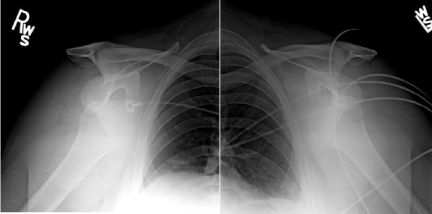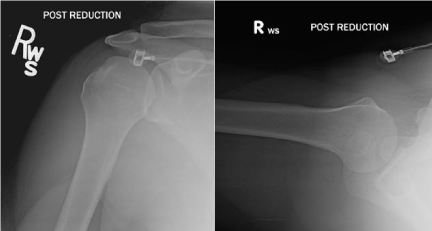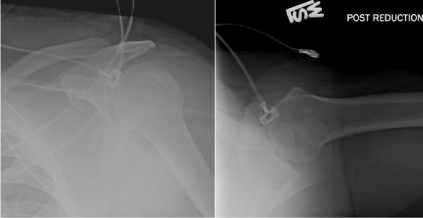
Case Report
Austin J Orthopade & Rheumatol. 2015;2(1): 1009.
Bilateral Simultaneous Anterior Shoulder Dislocation
Brett Auerbach*, Adam Bitterman, Vishal Mehta and Gus Katsigiorgis
Department of Orthopedic Surgery, North Shore Long Island Jewish - Plainview Hospital, USA
*Corresponding author: Brett Auerbach, Department of Orthopedic Surgery, North Shore Long Island Jewish - Plainview Hospital, New York 11803, USA
Received: November 19, 2014; Accepted: January 30, 2015; Published: February 03, 2015
Abstract
Bilateral simultaneous anterior shoulder dislocation is a rare occurrence. There are few cases reported in the literature and, when involving trauma, such incidents are usually associated with fracture. The majority of simultaneous bilateral shoulder dislocations reported is posterior. We discuss an unusual case of a 43-year-old male who presented to the emergency department with bilateral shoulder pain associated with movement after sustaining a jet skiing accident. The patient was found to have bilateral anterior gleno-humeral dislocations without fracture. He had no prior history of dislocation. Both shoulders were ultimately reduced in the emergency department with conscious sedation using traction-countertraction techniques.
Keywords: Bilateral simultaneous; Shoulder; Traction-countertraction
Introduction
Shoulder dislocation is an extremely common injury and anterior is more frequent than posterior when unilateral. Bilateral simultaneous shoulder dislocations are rare. The majorities of simultaneous bilateral dislocations reported in the literature are posterior and typically associated with seizure activity or electrocution accidents [1-4]. Although rare, cases of bilateral anterior dislocations involving exercise activities, such as push-ups, bench presses and pullover maneuvers, have been reported [5-7]. When traumatic in nature the majority of simultaneous anterior dislocations are associated with fracture [4].
This case report is unique as it describes a 43-year-old male with no prior history of dislocation who presented with bilateral simultaneous anterior gleno-humeral dislocations without fracture as a result of a jet skiing accident. The mechanism of injury is distinctive from cases previously described in the literature and there was no evidence of epilepsy or electrocution. It is likely that the position of his shoulders at the time of impact may have contributed to this injury.
Case
A 43-year-old male presented to the emergency department with bilateral shoulder pain 12 hours after being involved in a collision while on a Jet Ski. Once back on shore, he did not seek immediate medical attention. The patient was on vacation with his family at the time of injury. They chose to drive to an emergency department near his home in order to seek treatment. His wife drove the car while he sat in the back seat. The travel time took significantly longer than expected due to traffic conditions.
Upon arrival to the emergency department, the patient complained of bilateral shoulder pain associated with any shoulder motion. Pain was relatively controlled at rest. He was neurovascularly intact. Bilateral sulcus signs were present.
Plain film radiography demonstrated bilateral anterior shoulder dislocations (Figure 1). There was no associated fracture. He did not have any prior history of shoulder dislocation.

Figure 1: AP shoulder radiographs demonstrating bilateral anterior shoulder
dislocations.
Conscious sedation was administered and bilateral shoulders were reduced without complication. Traction-countertraction techniques were utilized to reduce the shoulders one at a time. Post-reduction radiographs were obtained and demonstrated bilateral reduction without fracture (Figure 2,3). Both shoulders were immobilized in a sling for 48 hours and then progressive ROM exercises were performed.

Figure 2: AP and axillary radiographs of the right shoulder post-closed
reduction.

Figure 3: AP and axillary radiographs of the left shoulder post-closed
reduction.
Discussion
The above case illustrates bilateral simultaneous anterior shoulder dislocation as a result of a jet skiing accident. The positioning of the shoulders in an abducted position on the handlebars may have contributed to the mechanism of injury at the time of impact. The literature suggests that bilateral simultaneous shoulder dislocations are rare. The majority of bilateral shoulder dislocation cases reported tends to be posterior in nature [1-4]. The proposed rationale for this is that a simultaneous force needs to be applied to both shoulders in order to sustain a bilateral dislocation. In the case of posterior dislocation, the simultaneous force tends to be the result of muscle contractions due to electric shock or seizure [1-4]. There are at least three cases of exercise-related simultaneous anterior dislocations due to push-ups, bench presses and pullover maneuvers [5-7]. There are also case reports of simultaneous anterior shoulder dislocations after trauma; however, the overwhelming majority of these cases are associated with at least one proximal humerus fracture [8-10]. Cases of anterior dislocation without fracture tend to involve older patients with minor trauma [11,12].
This case is unique in that it involves a 43-year-old healthy male who presented with bilateral anterior shoulder dislocations without fracture as a result of a jet skiing accident. The mechanism of injury, younger age and lack of previous dislocation is distinct from those previously reported. There was no evidence of seizure-like activity or electrocution injury. The shoulders were in a position of relative abduction and slight external rotation, while the patient was gripping the handlebars of the Jet Ski. We propose that the impact forced the shoulders into further abduction with an extension moment, which ultimately caused anterior dislocation of bilateral shoulders. Bilateral simultaneous anterior shoulder dislocation is rare. However, the principles of treatment are the same as unilateral. Treatment consists of closed reduction and a short period of immobilization. Clinicians must be aware of the possibility of bilateral anterior shoulder dislocation when evaluating patients.
References
- Brown RJ. Bilateral dislocation of the shoulders. Injury. 1984; 15: 267–273.
- Betz ME, Traub SJ. Bilateral posterior shoulder dislocations following seizure. Internal and Emergency Medicine. 2007; 2: 63–65.
- Brackstone M, Patterson SD, Kertesz A. Triple "E" syndrome: Bilateral locked posterior fracture dislocation of the shoulders. Neurology. 2001; 56: 1403–1404.
- Dinnopolous HT, Giannoudis PV, Smith RM, Mathews SJ. Bilateral anterior shoulder fracture-dislocation, A case report and a review of the literature. 1999; 23: 128-130.
- de la Fuente FA, Hoyte C, Bryant SM. Push-ups may be hazardous to your health: an atraumatic etiology for bilateral shoulder dislocation. The American Journal of Emergency Medicine. 2008; 26: 116.e3 - 116.e4.
- Cresswell T.R, Smith R.B. Bilateral anterior shoulder dislocations in bench pressing: an unusual cause. Br J Sports Med, 1998; 32: 71-72.
- Maffulli N, Mikhail H.M. Bilateral anterior glenohumeral dislocation in a weight lifter. Injury. 1990; 21: 254-256.
- Markel DC, Blasier RB. Bilateral anterior dislocation of the shoulders with greater tuberosity fractures. Orthopedics. 1994; 17: 945-949.
- Lin CY, Chen SJ, Yu CT, Chang IL. Simultaneous bilateral anterior fracture dislocation of the shoulder with neurovascular injury: report of a case. Int Surg. 2007; 92: 89-92.
- Sanjay Meena, Pramod Saini, Vivek Singh, Ramakant Kumar, Vivek Trikha. Bilateral anterior shoulder dislocation. Nat Sci Biol Med. 2013; 4: 499–501.
- Ngim NE, Udorroh EG, Udosen AM. Acute bilateral anterior shoulder dislocation following domestic assault--case report. West Afr J Med. 2006; 25: 256-257.
- Dunlop CC. Bilateral anterior shoulder dislocation-a case report and review of the literature. Acta Orthop Belg. 2002; 68: 168-170.